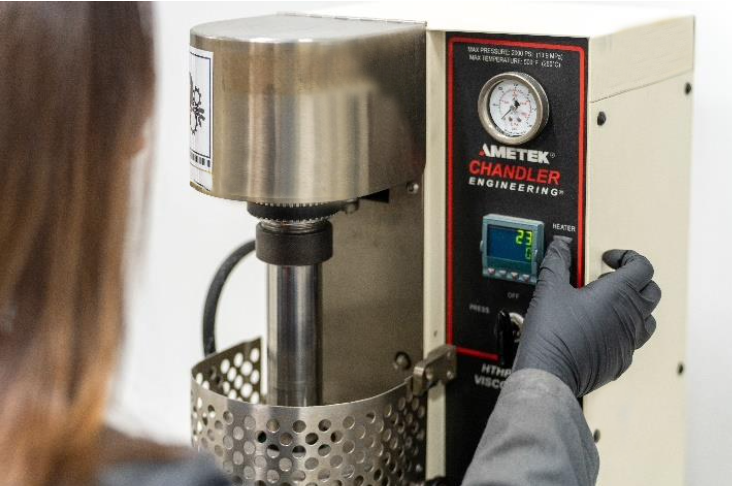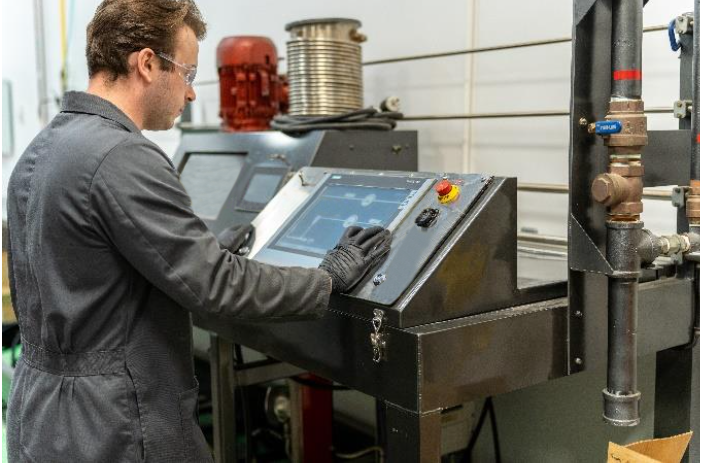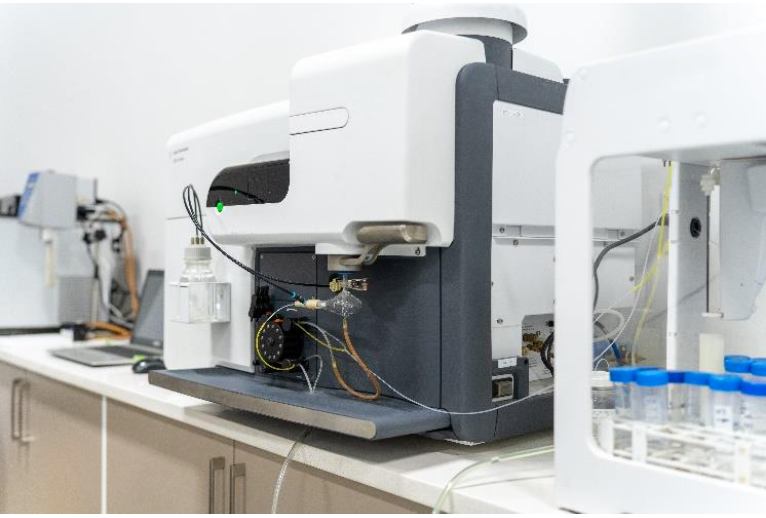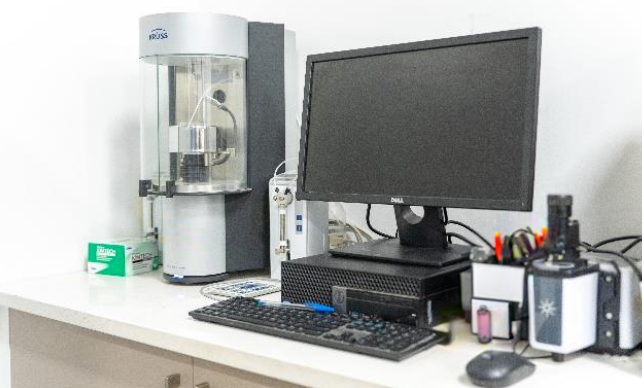RHEOLOGY

Brookfield PVS
A Brookfield PVS Rheometer is a viscometer that can measure viscosity of various oilfield fluids (typically a crosslinked fracturing fluid) over time and temperature; this machine can simulate specific down -hole conditions. The sampled fluid is contained under pressure within the annular space between a rotating rotor and bob. A shear rate is applied and the thickness of the fluid creates torque on the bob. The resultant viscosity can be tracked over time to track the stability or degradation of a fluid.

CHANDLER 5550 HP / HT
The Chandler 5550 Viscometer is a high-pressure high-temperature viscometer designed to test a variety of oilfield fluids; the measured fluid is contained within the annular space between a rotating rotor and bob. A shear rate is applied and the thickness of the fluid creates torque on the bob. The resultant viscosity can be tracked over time to track the stability or degradation of a fluid.
Brookfield DV-II
A Brookfield DV-II Rheometer is a low-temperature low-shear rate viscometer that can measure viscosity of a various oilfield fluids over time and subzero temperatures. The sampled fluid is contained within the annular space between a rotating rotor and bob. This creates torque on the bob which can be translated to shear rate and viscosity and can be used to simulate in-hole conditions.
Fann35, Marsh Funnel
A Fann 35 viscometer measures the viscosity in centipoise through shear stress between a sample fluid and the annular space between a rotating rotor and bob. A Marsh Funnel is filled with a fluid and the time it takes to drain the funnel is used to calculate the effective viscosity in centipoise.
WATER ANALYSIS
pH, Salinity, TDS
pH can be determined via pH indicator strips, electronic pH meters or through titration in the lab. Salinity can be determined by placing a few drops of water sample onto a handheld refractometer, which gives an immediate reading of salinity percentage. Total dissolved solids (TDS) can be determined through water analysis via MP-AES (Microwave Plasma Atomic Emission Spectroscopy).
Iron, Chlorides
Iron can be determined via UV-vis spectrometry or with field ferrous iron test kits. Water samples are mixed with indicator chemicals, these react and form colored products that are proportional to the amount of iron present, UV-vis will calculate this concentration while iron test kits can be compared to a color wheel to find concentrations. Chloride concentration can be determined via titration in the lab.
IRP 8 TESTING EQUIPMENT
Closed Cup Flashpoint
In a Closed Cup Flashpoint test a hydrocarbon sample is loaded into a heated closed cup, the cup will continue to heat slowly and the headspace in the cup will be exposed to an ignitor. If the vapor ignites, the flashpoint instrument will record this temperature as the flash point.
Reid Vapor Pressure
A hydrocarbon sample is loaded into a Reid Vapor Pressure Bomb and heated in a water bath at a steady temperature. The bomb will be inverted multiple times until the pressure stabilizes, the gauge will show a steady pressure, this is the Reid Vapor Pressure.
ACID MATRIX & SPEARHEAD
Acid / Oil compatibility
Provided or prepared acids and oils are mixed vigorously and heated over time at a specified bottom hole temperature. Separation is observed and solutions are poured through filters to check for the presence of sludge. Incompatibilities can be observed through poor separation and sludge formation.
Titration
Titrations are used to determine the concentration of an acid by adding a known concentration of a base. An indicator such as phenolphthalein is added to the unknown acid and upon an increase of pH (addition of a base) the solution will change color. The amount of base required for color change can be compared to a known standard curve and the concentration of acid can be determined.
LUBRICITY TESTING
Metal-to-Metal
Lubricity testing allows for the direct comparison between different metal lubricants. The lubricity test can be measured at a range of 10 – 600 in-lb torque and various rpm to read out a metal-to-metal friction coefficient.
PARAFFIN & ASPHALTENE
WAT
An oil’s wax appearance temperature (WAT) measures the point at which oil first precipitates waxes or paraffins. The DV-II cools a crude oil sample down while measuring the viscosity. This can determine the temperature at which wax formation occurs which can quantify the effectiveness of paraffin inhibitors.
SARA Analysis
SARA oil testing measures saturates, asphaltenes, resins, and aromatics in crude oil and distillates. These compounds are separated and percentages of each are calculated through liquid chromatography.
FRICTION REDUCTION

Flowloop Pressure Drop
The Flowloop Pressure Drop can be used to determine the friction reduction capabilities of various additives, water samples are loaded into the machine and friction is measured over time and upon addition of a friction reducer. The friction reduction is computed from pressure changes in the tubing.
VISCOELASTICITY
G ’/ G’’ / n*
Viscoelasticity testing quantifies the fluid properties of various fluids used in well servicing. These viscous fluids are non-Newtonian fluids which behave differently under various shear rates. Using ISO 13503 testing we are able to model the elastic and consistency index for viscoelastic fluids. These rheological parameters correlate to the fluid’s ability to transport proppant.
CLAY MITIGATION
Capillary Suction Timer
The capillary suction timer measures the time it takes for a sample fluid to advance between radially separated electrodes touching a fixed area of special filter paper. Additives can influence the time it takes the solution to permeate through the filter paper, as clay particles can cause the pores of the filter to become clogged, a shortened time frame indicated quicker travel and less chance of clogging.
Fines Settling
Fine migration testing is done through turbidity measurement to evaluate the settling rate of fines in an aqueous medium. Fines samples sieved to a consistent grain size are homogenized in water with fines control additives, left to rest for a time, and water turbidity is measured with lower turbidity indicating more effective fines control.
MICROBIOLOGY
Population Count
Bacteria levels can be determined via ATP (Adenosine triphosphate) measurement by using a luminometer. The ATP test uses a reaction that generates light when ATP is present. This light is detected by the luminometer, and this detected light can be compared to a known calibration standard to determine the amount of bacteria present as colony forming units (CFU/mL).
Kill Studies
When samples have high bacteria a kill study can be conducted with various biocides. Water samples are treated with biocides and left for a time in an incubator, the samples are then retested and a kill percentage is calculated.
APB / SRB Culture Growth
Acid producing bacteria (APB) and sulfate reducing bacteria (SRB) can be hazardous due to corrosion of equipment and souring of formations. Being able to identify these dangerous bacteria can recognize potential issues before they occur. Biological activity reaction test (BART) can identify the active types of bacteria in a given water source.
FOAM QUALITY, HALF-LIFE
Foam quality and half-life can be determined by exposing solutions with foaming agents to high sheer conditions in a blender and tracking the decrease of foam over time. The reduction of foam can then be used to quantify foam quality and half-life through a series of calculations.
CORROSION TESTING
Static Coupon
Static coupon corrosion testing determines the corrosion rate of a system via a mass loss experiment. A solution to be tested is added to a container along with a pre-weighed coupon, the solution is not stirred (static conditions), heated for a time (with pressure or without) and the coupon is reweighed and a weight difference is reported. Pitting of the coupon is also measured and reported in accordance with a graded scale of pitting severity.
LT / LP (up to 90°C)
Low temperature low pressure (LTLP) corrosion rate determination is used to identify the corrosion rate of a system via a mass loss experiment. A solution to be tested is added to a flask or bottle along with a pre-weighed coupon, the solution is heated for a time and the coupon is reweighed and a weight difference is reported. Pitting of the coupon is also measured and reported in accordance with a graded scale of pitting severity.
Dynamic Coupon
Dynamic coupon corrosion testing determines the corrosion rate of a system via a mass loss experiment. A solution to be tested is added to a container along with a pre-weighed coupon, the solution is stirred (dynamic conditions), heated for a time and the coupon is reweighed and a weight difference is reported. Pitting of the coupon is also measured and reported in accordance with a graded scale of pitting severity.
HT / HP (up to 200C°)
High temperature high pressure (HTHP) corrosion rate determination is used to determine the corrosion rate of a system via a mass loss experiment. A solution to be tested is added to a bomb chamber along with a pre-weighed coupon, the bomb is heated for a time and the coupon is reweighed and a weight difference is reported. Pitting of the coupon is also measured and reported in accordance with a graded scale of pitting severity.
SCALE ANALYSIS

Advanced Water Analysis
Microwave plasma-atomic emission spectroscopy (MP-AES) can be used for advanced water analysis. The AP-AES uses plasma to excite an atom, which emits light in a characteristic pattern of wavelengths or emission spectrum. The spectrum can be compared to known calibration samples and the MP-AES can determine the presence and concentration of various atoms and molecules.
Scale Tendency / DSL
Scale Tendency is the possibility of compounds to ‘fall out’ of solution and create scale formations. This can be determined by taking the water analysis results found with the MP-AES and calculating the saturation index of specific compounds. If the saturation index is high, there is a high scale tendency.
PROPPANT TESTING
API RP 56 / API STD 19C
Crush resistance (per API STD 19C) of sand can be tested via hydraulic press. Sand samples of determined sieved sizes are loaded into a hydraulic press, crushed under specified stress levels and put through sieves again, depending on the amount of sand that now goes through the sieve we can determine the ‘K-Value’ that designates the sands ability to withstand stress.
SURFACTANT & EMULSION
IFT / ST
The Spindle-drop Tensiometer determines the compatibility of the oil and aqueous phase via measuring the interfacial tension. The lower the interfacial tension the easier emulsions will be to keep separated into their respective phases.
Oil / Gel compatibility
Shake-bottle testing is a qualitative test in which oil and a frac blend are mixed and heated to bottom- hole temperature over time. The phase separation can be observed visually, and any incompatible material will be sieved out post heating.
Stacked Column
Column drainage is the technique in which proppant and cuttings are stacked within a column using a surfactant dosed source fluid. This testing shows the effect of the surfactant influencing the production of oil through proppant packed fractures showing percentage oil recovered, and total fluid recovered.
UNKNOWN ANALYSIS
XRD / XRF
X-Ray Diffraction is a process in which an unknown solid is subjected to X-rays that can diffract off the crystals within the sample. The diffraction patterns are then compared to a database of many ionic compounds to determine the identity and percentage within the sample.
GC-MS
Gas Chromatography – Mass Spectrometry is the process of an unknown mixture of substances being carried by an inert gas such as helium through a heater to separate. Once separated the molecules are sent through a mass spectrometer to read out the identity of molecular compounds of the unknown sample.

FTIR
Fourier transform infrared (FTIR) spectroscopy uses infrared radiation to pass through a sample, the radiation that passes through the sample is recorded as an infrared spectrum. This infrared spectrum of absorption or emission of a gas, solid, or liquid, acts as a molecular ‘fingerprint’ of the sample and can be used to identify the presence of various chemical structures.
HPLC
High-performance liquid chromatography (HPLC) is a technique used to separate, identify, and quantify each component in a mixture by pressurizing liquid solvent containing the sample through a column filled with solid adsorbent material. Each sample interacts differently with the adsorbent material, causing different flow rates for each component and separating the components as they leave the column.

Solutions Driven. Client Focused.
Contact US
Follow Us

Solutions Driven. Client Focused.
Contact US
Follow Us